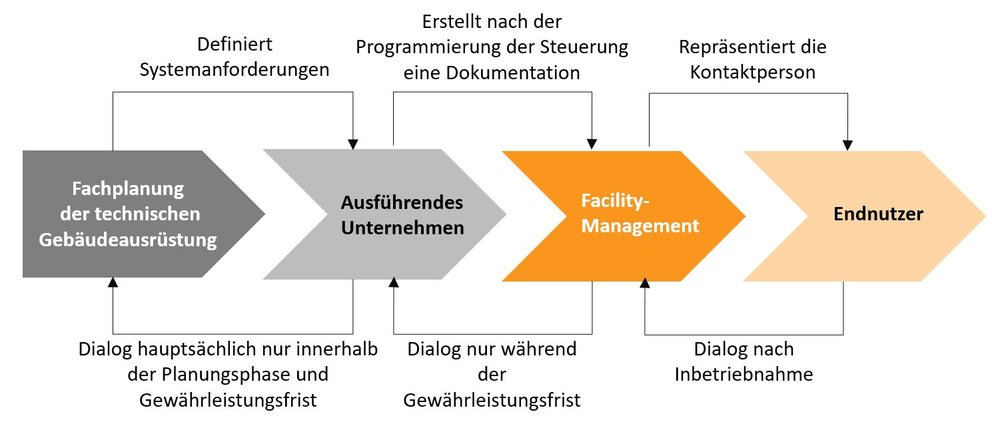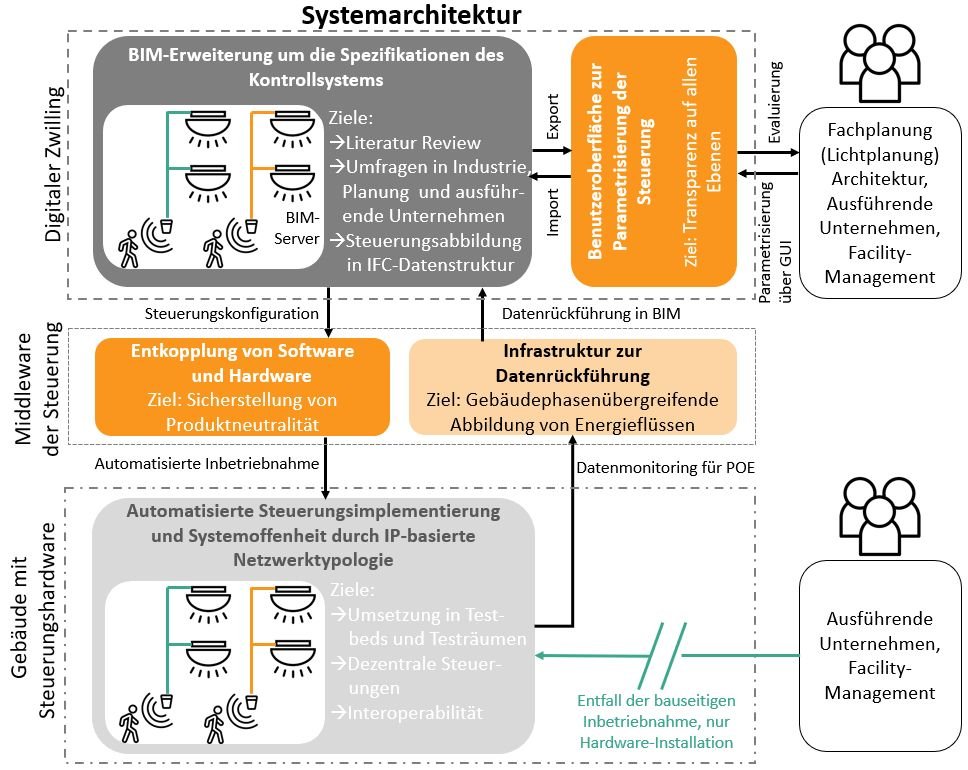TwinLight - BIM-based realisation of daylight and artificial lighting control systems
Project management: Zumtobel Lighting GmbH
Project manager University of Innsbruck (Energy Efficient Building Unit): Rainer Pfluger
Project staff: Sascha Hammes, Daniel Plörer, Vincent van Karsbergen, Martin Hauer, David Geisler-Moroder
Project consortium:
- Zumtobel Lighting GmbH
- Hella Sonnen- und Wetterschutztechnik GmbH
- University of Innsbruck, Department of Structural Engineering and Material Sciences
- University of Innsbruck, Department of Computer Science
Funding organisation: Österreichische Forschungsförderungsgesellschaft mbH (FFG)
Funding programme: City of the Future
Funding amount: 108,428 euros (UIBK-EEB)
Duration: 01.10.2022 until 30.09.2025
Project website: https://nachhaltigwirtschaften.at/de/sdz/projekte/twinlight.php
Summary
Initial situation/motivation
IT-based control systems for non-residential buildings are currently planned in the course of tenders based on functionality requirements. Based on this catalogue of requirements, the selection and installation of the control system is carried out purely on site and usually on a trade-specific basis. As a result, there is a lack of transparency towards higher planning levels and other parties involved in construction, making it difficult to assess the quality and system performance of the implemented building control system. This problem is exacerbated by the lack of post-occupancy evaluation in most cases. Furthermore, the manufacturer's choice of control hardware, which is usually centralised, often results in restrictions with regard to interoperability with other systems, system expandability and variability, e.g. due to proprietary protocols. As a result, the on-site commissioning of such control logics, especially for complex target applications, can be time-consuming and therefore costly, and can lead to quality deficits that ultimately result in a lack of energy efficiency or insufficient user comfort within the building operation.

Content and objectives
In recent years, digital building models based on the Building Information Modelling (BIM) standard have been made usable for all phases of a building's life cycle with the aim of improving efficiency in all phases, as well as increasing user comfort and energy efficiency. For the daylighting and artificial lighting trades, as the central trades, there are opportunities to significantly simplify commissioning on site and to utilise new possibilities for maintenance, monitoring and improving building operation. The aim of the TwinLight project is to develop a BIM-based digital twin that brings the entire life cycle for daylighting and artificial lighting to the BIM level.
Methodological approach
The TwinLight framework is intended to encompass the model-based control of lighting technology in buildings and thus support the coordination of lighting designers, facility managers and manufacturers in the planning, validation, configuration, optimisation and maintenance of lighting systems. The logic of the control system is thus raised to a higher planning level and enables new analyses and data-driven feedback loops, e.g. to increase energy efficiency and user quality in the building. As part of the project, the control software must be detached from proprietary systems by designing middleware based on an open-system, IP-based network topology. The project is being carried out on an interdisciplinary basis in the fields of building technology (specifically daylight and artificial lighting), energy-efficient construction and Computer Science (model engineering). The developed concept is being tested in terms of its applicability, system stability and functionality both in test rooms and in real-life applications. By involving end users from all construction project phases in the design and evaluation, the aim is to create a high degree of usability of the desired system architecture in order to make construction processes more efficient and improve energy efficiency in the future.
Expected results
The aim is to create a BIM-based user tool for lighting control systems that ensures transparency between those responsible, enables ongoing system adjustments and automates the commissioning of control systems on site using BIM2Control data transfer. Energy and process data is to be mapped in the digital twin across all construction phases via information feedback of data from operation (Control2BIM). The advantages of integral concepts, potential in the area of personalisation and ICT technologies are to be exploited via an open system architecture.

Source: https://nachhaltigwirtschaften.at/de/sdz/projekte/twinlight.php
Tasks in the project
BIM and integral controls are two important topics for the building sector and also offer potential in terms of energy efficiency and user comfort. The UIBK-EEB has been working on both topics for several years in research projects and also as a communication interface to the local economy. For this reason, UIBK-EEB is responsible for establishing requirement criteria for BIM-based control parameterisation and, at the same time, ensuring that integral control systems are mapped and all necessary specifications are entered into the BIM feature server. In addition, UIBK-EEB is leading the relevant literature research. In addition, the UIBK-EEB supports the development of integral control logic based on numerous past research projects (including BIM2IndiLight, VisErgyControl) on control systems. Furthermore, the department supports the development of the bidirectional workflow and provides expertise in the fields of energy and BIM for the implementation of field studies.
Funding
"City of the Future" is a research and technology programme of the Federal Ministry for Climate Action, Environment, Energy, Mobility, Innovation and Technology. It is organised on behalf of the BMK by the Austrian Research Promotion Agency (FFG) together with Austria Wirtschaftsservice Gesellschaft mbH (AWS) and the Austrian Society for Environment and Technology (ÖGUT).



